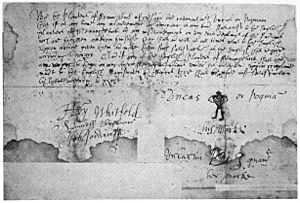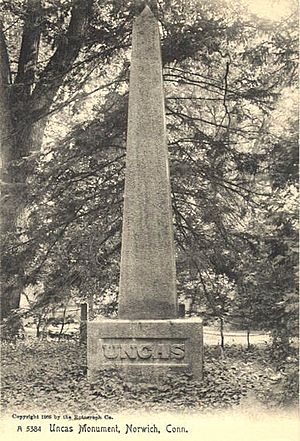Uncas facts for kids
Uncas (around 1588 – around 1683) was a powerful leader, called a sachem, of the Mohegan people. He helped the Mohegans become the most important Native American tribe in lower Connecticut. He did this by making friends with the New England colonists and fighting alongside them against other Indian tribes.
Contents
Uncas's Early Life and Family
Uncas was born near the Thames River in what is now Connecticut. His father, Owaneco, was also a Mohegan sachem. The name Uncas comes from the Mohegan word Wonkus, which means "Fox".
He was related to important leaders of the Mohegans, Pequots, and Narragansetts. Uncas grew up speaking Mohegan and learned some English, and maybe even some Dutch.
In 1626, Uncas's father arranged for him to marry the daughter of Tatobem, a main Pequot leader. This marriage was meant to create a strong friendship between the Mohegans and Pequots. After his father died, Uncas had to follow Tatobem's rules.
In 1633, Tatobem was captured and killed by the Dutch. Sassacus became the new Pequot leader, but Uncas felt he should have been the one to lead.
At first, the Mohegans and Pequots had a balanced power. But after Uncas's father died, the Pequots became much stronger. Uncas didn't want to challenge Tatobem, but he did start to question the Pequots' power over the Mohegans.
In 1634, with help from the Narragansetts, Uncas rebelled against Sassacus and the Pequots. Uncas lost the fight and had to live away from his home with the Narragansetts for a short time. He soon returned after showing respect to Sassacus.
Because of his failed attempts, Uncas had little land and few followers. But he noticed that the new Puritan colonists, even though there weren't many of them, had better weapons and were very brave. Uncas decided to try a new plan: he would make friends with the colonists to help him become a powerful leader.
The Pequot War
Around 1635, Uncas started to build relationships with important people in the Connecticut Colony. He became a trusted friend of Captain John Mason. Their friendship lasted for over 30 years and even continued with their families.
Uncas sent a message to Jonathan Brewster, warning him that Sassacus was planning to attack the colonists on the Connecticut River. Brewster said that Uncas was "faithful" to the colonists.
In 1637, during the Pequot War, Uncas and his Mohegan warriors fought alongside the New England colonists against the Pequots. He led his Mohegans in joint attacks with the colonists near Saybrook and against the Pequot Fort at Mystic River.
The Pequots were defeated. After the war, the Mohegans took in many of the remaining Pequot people and their land. In the 1638 Treaty of Hartford, Uncas agreed that the Mohegans would be a "tributary" tribe to the Connecticut River Colony. This meant they would pay tribute or show loyalty to the colony. The treaty said that Uncas could only use the Pequot land if the Connecticut Colony agreed. The Mohegans had now become a strong power in the region.
In 1640, Uncas married Sebequanash of the Hammonassets. This marriage gave Uncas some control over their land, which he quickly sold to the New England colonists. The Hammonassets then moved and became part of the Mohegan tribe.
War with the Narragansett
The Mohegans and the Narragansetts often fought over who controlled the land that used to belong to the Pequots. In the summer of 1643, this fighting turned into a full-scale war.
The Mohegans defeated a Narragansett army of about 1,000 men and captured their leader, Miantonomo. Uncas killed some of Miantonomo's warriors in front of him, trying to make Miantonomo react. Following the 1638 treaty, Uncas handed Miantonomo over to the New England colonists.
The colonists put Miantonomo on trial and found him guilty. Uncas asked for and was given permission to kill Miantonomo. The colonists wanted the killing to be done by Native American hands in Native American territory to avoid problems between the Narragansetts and the colonists.
Miantonomo later escaped from the Mohegan village where he was held. He tried to jump over Yantic Falls to get away from the Mohegans chasing him. This place is also known as Indian Leap. Uncas's brother, Wawequa, caught up to Miantonomo and killed him with a tomahawk. A monument now stands near where Miantonomo died.
The Narragansett leader Pessachus wanted to go to war to get revenge for Miantonomo's death. But the colonists promised to support the Mohegans. Colonists from the New England Confederation formed an alliance with the Mohegans to protect them.
The Narragansett attacks began in June 1644. As the Narragansetts won more battles, more tribes joined them. In 1645, Uncas and the Mohegans were surrounded in Fort Shantok and were close to being completely defeated. But the colonists, led by Thomas Tracy and Thomas Leffingwell, brought them supplies and ended the siege. The New England Confederation promised to take any action needed to keep Uncas "in his liberty and estate." They even sent troops to defend the Mohegan fort at Shantok. When the colonists threatened to invade Narragansett land, the Narragansetts signed a peace treaty.
In 1646, a smaller tribe called the Nameag, who were former Pequots, allied with the colonists and tried to become more independent. Uncas attacked and robbed their village in response. The Bay Colony governor threatened to let the Narragansetts attack the Mohegans. For several years, the New England colonists both said the Nameag tribe was under their control and helped them be independent. In 1655, the New England government removed the Nameag tribe from Uncas's authority.
King Philip's War
King Philip's War started in June 1675. In the summer, the Mohegans joined the war on the side of the New England colonists. Uncas led his warriors in joint attacks with the colonists against the Wampanoags. In December, a combined force of New Englanders and Mohegans attacked a group of Narragansetts. The Mohegans continued to support the colonists until the war ended in July 1676.
Uncas died sometime between June 1683 and June 1684 in Norwich, Connecticut.
Uncas's Legacy
- President Jackson laid the first stone for a monument to Uncas in Norwich, Connecticut.
- Uncas Pond in Franklin, Massachusetts, is named after him.
- In 1907, William F. Cody placed a wreath on Uncas's monument to honor him as the "Last of the Mohegans."
- James Fenimore Cooper's famous book The Last of the Mohicans features a character named Uncas, who is the son of Chingachgook.
- The two-masted wooden ship Diosa del Mar was originally named Uncas by the Vanderbilt family who owned it.
- Four United States Navy ships have been named USS Uncas.
- Uncasville in Eastern Connecticut is named after him.
- Uncas Lake in Nahantic State Forest, Lyme, Connecticut, is also named after the sachem.
- In the ceremonies of the Boy Scouts of America honor society, the Order of the Arrow, a young man named Uncas is shown as the son of a fictional Lenni Lenape chief named Chief Chingachgook. This Uncas is sent on a mission to unite the tribes of the Delaware Valley.
- In the DC comic book Superman #276 (June 1974), one of the super-hero Captain Thunder's powers is "the bravery of Uncas."
See also
 In Spanish: Uncas para niños
In Spanish: Uncas para niños



